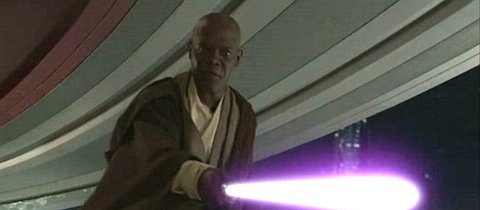
Written: 2005-05-30
Last Updated: 2005-09-09
Warning: spoilers everywhere!
After watching the first two movies, you might never have guessed that Mace Windu would turn out to be one of the most important characters in the entire six-film Star Wars saga, but it turns out that he is. And it all revolves around a single pivotal moment in time: a flash of a blade that seals the fate of a galaxy.

That moment comes at the end of Mace Windu's fight with Chancellor Palpatine, and there is considerable debate over the nature of this fight. Some believe that he won the fight, exactly as it appeared on-screen, while others believe that Palpatine was actually toying with him and only pretended to lose for Anakin's benefit. As a basic point of logic, anything contrary to the most straightforward interpretation bears the burden of proof, so those who say that Palpatine "threw the fight" must produce evidence to back up their claim. So far, I have not seen any such evidence.
Some argue that Palpatine must have thrown the fight because Yoda is implied (albeit not clearly stated) to be the most powerful Jedi, but Anakin's dialogue in AOTC implies the opposite: that Mace Windu might actually be more powerful than Yoda. In any case, there is compelling reason to believe that Mace Windu was uniquely qualified to defeat Palpatine, regardless of whether he is equal to Yoda. That reason lies in his Vaapad fighting style, which actually employs the Dark Side. This is described in the novelization (p.329):
Vaapad is as aggressive and powerful as its namesake, but its power comes at great risk: immersion in Vaapad opens the gates that restrain one's inner darkness. To use Vaapad, a Jedi must allow himself to enjoy the fight; he must give himself over to the thrill of battle. The rush of winning. Vaapad is a path that leads through the penumbra of the dark side.
Mace Windu created this style, and he was its only living master.
This is interesting in light of Windu's choice to use a purple lightsabre, since we know that Sith prefer red lightsabres and Jedi prefer blue or green lightsabres, and if you mix blue and red, you get purple. Of course, if we step out of the movie world and into reality we find that Samuel L. Jackson simply thought that a purple lightsabre would look cool, but in the context of the movie world, this explanation conveniently works. In any case, on p.330 we read:
There was a time when Mace Windu had feared the power of the dark; there was a time when he had feared the darkness in himself. But the Clone Wars had given him a gift of understanding: on a world called Haruun Kal, he had faced his darkness and had learned that the power of darkness is not to be feared.
He had learned that it is fear which gives the darkness power.
He was not afraid. The darkness had no power over him. But-
Neither did he have power over it.
Vaapad made him an open channel, half of a superconducting loop completed by the shadow [Palpatine]; they became a standing wave of battle that expanded into every cubic centimeter of the Chancellor's office. There was no scrap of carpet nor shred of chair that might not at any second disintegrate in flares of red or purple; lampstands became brief shields, sliced into segments that whirled through the air; couches became terrain to be climbed for advantage or overleapt in retreat. But there was still only the cycle of power, the endless loop, no wound taken on either side, not even the possibility of fatigue.
Impasse.
At the very least, it's clear that Windu was an even match for Palpatine. Thanks to his Vaapad technique, Windu could also reflect Sith lightning back toward its source without harming himself, as we see on p.332-333:
Vaapad is more than a fighting style. It is a state of mind: a channel for darkness. Power passed into him and out again without touching him.
And the circuit completed itself: the lightning reflected back to its source.
My wife (who is always correct, of course) said that after reading the novelization and watching the movie, she concluded that because of Vaapad, Mace Windu was the only Jedi in the galaxy other than Anakin who could have defeated Palpatine. Contrast this to Yoda (p.398):
The shadow could feel how much it cost the little green freak to bend back his lightnings into the cage of energy that enclosed them both; the creature had reached the limits of his strength.
|
|
In short, unlike Windu, Yoda could not redirect Palpatine's lightning without draining himself of power. While the battle may have appeared close, Yoda had used up his last reserves of energy by the end and had no choice but to retreat. Therefore, the novelization seems to support the conclusion that Mace Windu was the only man in the galaxy (other than Anakin) who stood a chance to defeat Palpatine.
Of course, there is a counterpoint which opponents of this viewpoint will raise: despite its colourful descriptions of the Vaapad style and the seeming impasse between Windu and Palpatine, the novelization also describes Windu being unable to hold his blade against the power of Palpatine's Force lightning at the end, and being pushed back. However, the movie itself shows no such thing; Windu recovers quickly and begins pushing the blade toward Palpatine despite the lightning storm. Yoda, in contrast, looks frail and exhausted as he crawls away to escape. And while it is true that Yoda did not need a lightsabre to deflect Sith lightning, he had no lightsabre at the end because Darth Sidious had just blown it out of his hands with Sith lightning: something he was unable to do to Mace Windu.
This debate is sufficiently tricky that the Powers That Be at Lucasfilm have taken the rather unusual step of commenting directly on it. These comments indicate that the scene was changed from its original version to make it less likely that Palpatine threw the fight, and were made in the "Star Wars Homing Beacon" E-mail newsletter that is periodically sent out to Hyperspace subscribers. You can see the text of this statement on my site forums here.
In any case, Mace Windu's death sealed the fate of the galaxy, and in many ways it was caused by his own character flaws. He had made little effort to conceal his dislike and distrust of Anakin Skywalker ever since Anakin was a little boy, and Anakin is a character who is driven not by loyalties to ideology, but by loyalties to people. In essence, in the most critical moment of the entire six-film Star Wars saga, Anakin Skywalker found himself facing two men: one of whom who had befriended him since childhood and the other who had disliked him, distrusted him, and tried to block his path at every conceivable turn.
In short, while Mace Windu may have been the ideal Jedi to fight Emperor Palpatine, he was the worst possible Jedi to keep Anakin from making the wrong decision. Windu's strict and uncharismatic character, who seems so arbitrary and unimportant in the first two movies, turns out to be a remarkably important character to the fate of the galaxy. And while some disliked the character for his cold and aloof manner, it was precisely those qualities which made him so crucial to Anakin's fall. And to make a bad situation worse, Windu had been planning to forcibly remove Palpatine from power even before he had learned that Palpatine was a Sith Lord: a fact that undoubtedly influenced Anakin when Palpatine accused Windu of being a traitor.
It turns out that they're the same person. Who knew? Well OK, everyone knew. But believe it or not, there really were pockets of deluded fandom who continued to deny the painfully obvious fact that Senator Palpatine was Darth Sidious, and would eventually become Emperor Palpatine. Even the most hard-headed of them cannot deny this any longer.
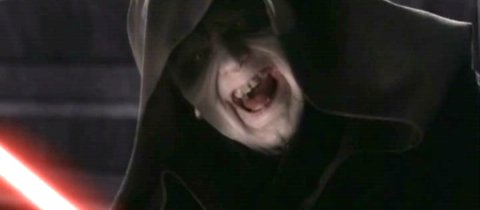 But
beyond that ridiculously obvious revelation, we learn that
surprisingly, Palpatine is quite deadly with a lightsabre (thanks in
part to his ability to use the Force to distract his enemies and
cloud their perceptions) and, armed with the combination of his
lightsabre skills and his Dark Side Force lightning, was able to
defeat Master Yoda. While some believe that the battle was quite
close, the fact is that at the end of it Palpatine was still strong,
still cackling with laughter, while Yoda was crawling away, exhausted
and defeated. He had used up his last reserves of power deflecting
Palpatine's Force lightning in their final confrontation, and while
Palpatine still seemed to have plenty of power to spare, Yoda did
not.
But
beyond that ridiculously obvious revelation, we learn that
surprisingly, Palpatine is quite deadly with a lightsabre (thanks in
part to his ability to use the Force to distract his enemies and
cloud their perceptions) and, armed with the combination of his
lightsabre skills and his Dark Side Force lightning, was able to
defeat Master Yoda. While some believe that the battle was quite
close, the fact is that at the end of it Palpatine was still strong,
still cackling with laughter, while Yoda was crawling away, exhausted
and defeated. He had used up his last reserves of power deflecting
Palpatine's Force lightning in their final confrontation, and while
Palpatine still seemed to have plenty of power to spare, Yoda did
not.
We also learn something of Palpatine's past. He tells of a Sith legend about Darth Plagueis, who discovered the secret of creating life through the Dark Side of the Force and was killed by his own apprentice as he slept. The fascinating thing is that he was supposedly able to create life by manipulating the midichlorians, and of course, we know from Episode 1 that the midichlorians somehow conceived Shmi Skywalker's child. So while Palpatine never quite comes out and says that Darth Plagueis was his own master, it seems rather obvious from the smile that creeps across his face when he talks of Plagueis' apprentice killing him, and even more obvious when one recognizes that this must have taken place around the time that Anakin was born.
We also learn that Palpatine's genius is not in lies (despite what Yoda says about the Sith) but in carefully using the truth to his advantage. When the Jedi Council orders Anakin to spy on him, he disarms Anakin by correctly accusing them of doing precisely this, leaving aside the fact that their order is well justified by his own scheming. When the Jedi plot to overthrow him and temporarily seize control of the Senate, Palpatine correctly and truthfully characterizes this as an attempted unlawful rebellion, thus gaining the support of the Senate, leaving aside the fact that he himself was guilty of high treason and that the Jedi had good reason to try and stop him via any means necessary. When you look at the things he says to Anakin, to the Jedi, and to the Senate, you come to the surprising realization that he doesn't actually lie in this movie. He simply states the portions of the truth which are convenient to him, and ensures that those who know the rest of the truth do not live to speak it.
There is some fairly heated debate over the issue of his physical appearance. It has long been stated in the official literature that Palpatine's appearance was the result of the Dark Side of the Force corrupting his body. But in this movie, we learn that his deformed visage is the result of a single battle with Mace Windu, in which Windu channeled his own Force lightning back into him. Some have lamented this contradiction, but I do not believe it is a contradiction at all. If the Dark Side of the Force slowly corrupts his physical appearance through overuse, then it does not seem odd that a sustained, powerfully intense blast of Dark Side Force power could dramatically accelerate this process if it is redirected into his own body.
However, the issue does not end there. There have been many statements in official sources suggesting that Palpatine's face was a "mask" and that the real face of Sidious was revealed after that battle. Some have taken this literally, to mean that he was actually wearing some sort of disguise which was burned away by the Force lightning. However, we can see enough of Sidious' face in his previous appearances in TPM and AOTC to conclude that he does not look like that, so the "true face of Sidious" is a metaphorical concept, not a literal one. Some have also suggested that Palpatine was using the Force to artificially sustain his appearance, and that he simply stopped making the effort during his fight with Windu. But the novelization contradicts this view (p.336):
"And so the mask becomes the man," he sighed with a hint of philosophical melancholy. "I shall miss the face of Palpatine, I think; but for our purpose, the face of Sidious will serve. Yes, it will serve."
One might interpret this as support for the "disguise" argument, except for the fact that he makes it quite obvious that he would restore the face of Palpatine if he could. Obviously he can't, so he will miss it and move on. If it was nothing more than an artificial disguise in the first place, he could have easily created it again.
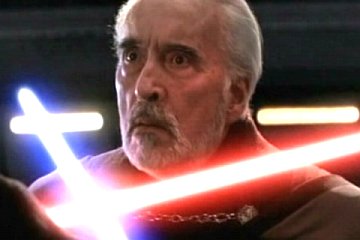 Ah,
poor Count Dooku. Or should we call you Darth Tyranus? For thirteen
years you've been carefully plotting, carefully conspiring with Darth
Sidious, waiting for the day when you would take Sidious' place and
assume your rightful place as the ruler of the galaxy. You were born
to great wealth, you positively ooze class and sophistication, you
have amassed power, and knowledge, and a lifetime of lightsabre
technique ... and now you're about to get your head chopped off by a
peasant from Tatooine. Sucks to be you.
Ah,
poor Count Dooku. Or should we call you Darth Tyranus? For thirteen
years you've been carefully plotting, carefully conspiring with Darth
Sidious, waiting for the day when you would take Sidious' place and
assume your rightful place as the ruler of the galaxy. You were born
to great wealth, you positively ooze class and sophistication, you
have amassed power, and knowledge, and a lifetime of lightsabre
technique ... and now you're about to get your head chopped off by a
peasant from Tatooine. Sucks to be you.
We don't really learn that much about Count Dooku in this movie, although the novelization says that he's an aristocratic snob and a racist. But perhaps more interestingly, it also describes his plan for turning young Skywalker to the Dark Side (p.67):
Quite simple, in the end, he thought. Isolate Skywalker, slaughter Kenobi. Beyond that, it would be merely a matter of spinning Skywalker up into enough of a frenzy to break through his Jedi restraint and reveal the infinite vista of Sith power.
Lord Sidious would take it from there.
So this is the plan: goad a Jedi into lashing out with anger and using the Dark Side of the Force. Once he has used the Dark Side, he can be easily corrupted by a Sith Lord into joining their cause. This was Tyranus' plan for Skywalker (although Sidious had his own plans), and it was clearly Palpatine's plan for Luke Skywalker at the end of ROTJ. One can only imagine that this is how he himself was corrupted.
While Count Dooku has apparently tried to separate himself from the more contemptible acts of the Confederacy of Independent Systems, General Grievous has not. According to the novelization:
Grievous is a monster.
The Separatist Supreme Commander is an abomination of nature, a fusion of flesh and droid- and his droid parts have more compassion than what remains of his alien flesh. This half-living creature is a slaughterer of billions. Whole planets have burned at his command. He is the evil genius of the Confederacy. The architect of their victories.
The author of their atrocities.
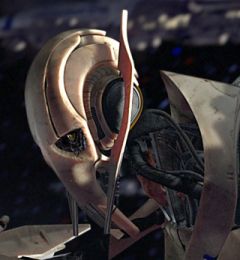 This
would appear to be the first movie or movie novelization reference to
planetary depopulation events. Grievous is described here as having
ordered many of them, and having killed billions in the process.
Small wonder, then, that the Republic wanted his head.
This
would appear to be the first movie or movie novelization reference to
planetary depopulation events. Grievous is described here as having
ordered many of them, and having killed billions in the process.
Small wonder, then, that the Republic wanted his head.
Grievous is also a remarkable example of SW medicine and its ability to replace virtually every biological system of a living organism with cybernetic equivalents. The only parts of General Grievous which appear to be original are his brain, his eyes, and a sac of withered organs wrapped in SynthFlesh. He doesn't even appear to have a spinal cord (unless you can see one in the picture at right; I certainly can't), which means that any connections between his brain and his organ sac must be made by artificial means.
Grievous' death is an interesting revelation from the point of view of those who have been arguing for years about the fate of Uncle Owen and Aunt Beru on Tatooine in Episode IV. There have long been those who claimed that it must be possible to burn someone's flesh off with blasters, since those are the only weapons that the stormtroopers appeared to be carrying at the time. Others have claimed that it's more likely the stormtroopers dumped flammables and set fire to the place, with Uncle Owen and Aunt Beru inside.
However, in this movie we see what happens when blasters hit unprotected flesh, and it's not pretty. Grievous' internal organs are immediately ignited, as can be seen in the accompanying picture. After several more hits, the flames become so violent that they ignore what remains of his eyes and brain, causing flames to shoot out of his eye sockets. Also, numerous bits of burning flesh are sent flying out of his chest cavity and can be seen burning on the deck even after he dies. The question of how this happened is somewhat more complicated, since one would normally expect a blaster to burn a hole through you rather than igniting you. Some have suggested that the SynthFlesh sac holding Grievous' organs must have been highly flammable, but this would seem like a curious design decision, to say the least. It is also difficult to reconcile with the fact that the flame did not appear to be self-sustaining. In other words, his organ sack glows brilliantly when first hit, then bursts into flame, and then the flame starts to die out before Obi-Wan hits him again, and again. The following frame is ¼ second after the first hit:
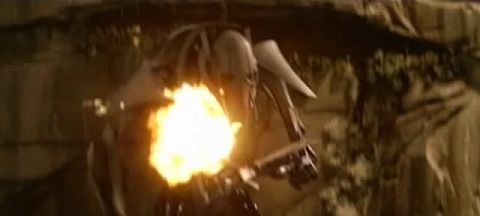
As you can see, his organ sac has burst into flame. But 1 second later, it looks like this:
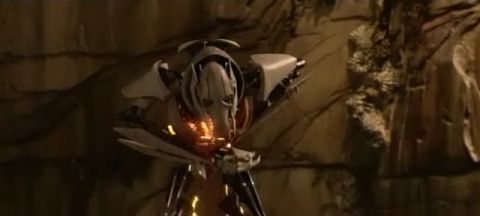
This does not look like a self-sustaining flame. The organ sac is glowing now, but not flaming. It takes another hit from Obi-Wan to re-ignite the flames, and several more to finish him off (although he might have died from the damage caused by the first hit; I imagine Obi-Wan was just taking no chances).
It is possible in principle for flesh to burn, but it requires highly unusual environmental conditions: very high heat, rapid flash-dehydration of the affected flesh, etc. One interesting idea is that Grievous' chest and back plates (which we know to be armoured and blaster-resistant) actually absorbed and reflected the energy. In other words, the plates surrounding his chest cavity might have functioned like the heat reflectors in a modern gas barbecue. This might help explain the oddities of this event.
In any case, one must decide which is more plausible: blasters being able to create such conditions at the point of impact (possibly with the assistance of heat reflection from the inside of Grievous' chest plates) or Grievous' designers deciding to make his organ sac out of pseudo-flammable materials.
Padmé's actions in this movie are of little consequence; her role in the story is to simply serve as an object of desire for Anakin (she has a somewhat more significant role in the novelization, where she has been covertly meeting with organizers of a nascent resistance movement which would eventually become the Rebellion). Her only real significant action in the film is to unwittingly lead Obi-Wan to Anakin on Mustafar. In a film with far greater gravitas than its two predecessors, the fate of billions will hang upon a single decision by one man, and Padmé is only important insofar as she affects that decision.
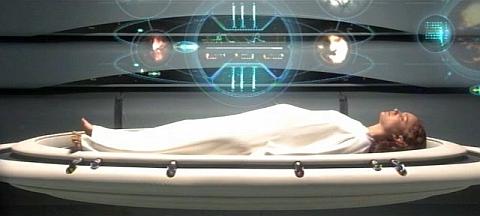
It is her death which is interesting, and which has generated some controversy. As she lies dying in the delivery room, the medical droid says "she has lost the will to live". This is supposed to explain her death despite lacking any serious physical injuries, but it really doesn't. Plenty of people in the real world lose their will to live all the time (you need only look at the suicide rates for confirmation of this fact), but if there's nothing medically wrong with them, they don't actually die until they commit suicide through some physical means.
Some have suggested that she was seriously injured when Anakin Force-choked her on Mustafar, but he obviously didn't cause her serious injury because the medical droids indicated that there was nothing medically wrong with her. So an alternate theory has arisen. Rather than paraphrase it, I will simply repeat the idea as posted on my forums:
Much has been made of Padmé's seemingly unnatural death at the end of the film. The medical droid said that she had apparently lost her will to live, but it's clearly implied that he couldn't explain why and we are left with an unsatisfying answer. It is arguable whether this explanation is consistent with Padmé's character; on one hand, she appeared to be fairly excited about being a mother and having children of her own. On the other hand, it is heavily implied in Episode II that Padmé had been a very lonely person before Anakin began putting the moves on her; this would explain why she so easily fell for Anakin, despite the awkward nature of his courtship, and also despite his massacre of the Tusken Raiders; what kind of a woman would just let something that horrible slide by? It is entirely possible that she had indeed lost her will to continue living, since she had lost the one thing that had filled the void in her empty life and the last thing she would have remembered about him would have been his attempt to choke her to death.
Another theory, a theory I think which is more satisfying in the context of the storyline and the tragic nature of Anakin's character, is that Palpatine was not lying when he told Darth Vader that he had killed Padmé through his anger; somehow, as he laid on the operating table, getting suited up for the first time, his anger, rage, and feelings of abandonment reached out through the Force (subconsciously) and drained away Padmé's will to live as she laid on the operating table, giving birth to the Skywalker twins. The movie is edited to where Anakin is operated on as Padmé gives birth; it may have been done this way to imply that Padmé's death was connected to Anakin becoming Vader and falling even more deeply into the grip of the Dark Side. Anakin's character is clearly meant to be evocative of the various Greek tragic figures; Padmé's death at his hands through the Dark Side of the Force would be consistent with his character, viewed in that light. He embraces the Dark Side to save her from her fate, but like a Greek hero desperately trying to evade his foreseen destiny, his attempts to escape fate only end up ensuring that the aforementioned fate will come to pass.
It has been suggested that Palpatine was simply lying to Anakin, but it must not be forgotten that Palpatine had previously demonstrated great insight into Anakin's mind. He knew that the Jedi had asked him to spy on the Senate, he knew that he was married, and he knew he had been having dreams of Padmé's death. Furthermore, it must be noted that Sith have a unique talent for using the truth deceitfully. How did Count Dooku attempt to sway Obi-Wan in Episode II? By telling him the truth about the Sith ...without telling him the full story. How did Palpatine get the Senate to support the Jedi purge? By telling them that the Jedi had staged a coup of the government, which they had actually done ... but again, without telling them the full story. And how did Palpatine explain Padmé's death to Vader to drive him even further down the dark path and make him even more vengeful and hateful? You get the idea. Again, Palpatine is using the truth deceitfully; Vader clearly believes that it was his force choke that accidentally killed her, but the way he actually killed her is far more sinister - how would Vader have viewed the Dark Side if he had known that he had subconsciously killed the love of his life through it? Palpatine is a lying, evil, twisted SOB - but it is through truth that he is able to accomplish his greatest victories. So what Palpatine tells Vader as he takes his first steps in the suit is not a lie, but a very literal truth.
Credit goes to Marina O'Leary and Joe (unknown last name; perhaps it is "Blow") for the above idea. The Dark Side of the Force is, after all, a pathway to many abilities, some considered to be unnatural. It's certainly more plausible that Anakin could have inadvertently killed Padmé with the Force than the idea of her somehow killing herself by wanting to die.
What do we learn about Yoda in this film that we didn't know before? Well, for one thing we learn that he is a very inflexible person, so wrapped up in his Jedi dogma that he can't see the forest for the trees. Yoda, if so perceptive you are, why notice not did you that Anakin was boinking Padmé? Obi-Wan knew; so what is your problem, O Perceptive One? He is the Chosen One, and you pay so little attention to him that you can't even tell he's chafing violently at the restrictions placed on him? Your restrictions?
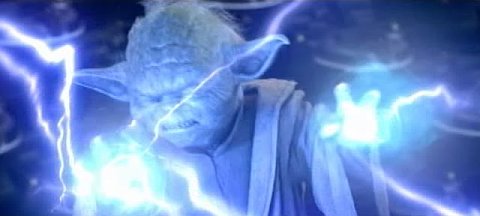
In the novelization, it is made clear that Yoda, being the oldest and most respected member of the Jedi Order, has essentially made it (and its rules) in his own image over the past eight centuries. There is no debate on these rules, there is no dissent permitted, and it is quite clear that membership in the Jedi Council is contingent upon being a meekly agreeable Yoda Yes-Man, which is why Qui-Gon Jinn never made it into the club.
If Star Wars Episode 3 is a Greek tragedy, then Anakin Skywalker is not its only tragic figure. Yoda, for all his supposed wisdom, preaches the virtue of selflessness not because he believes he should help others, but because that's the Code. The Code now exists for its own sake, and over the centuries, he's forgotten why. In Episode 1, Qui-Gon Jinn would obviously like to help Anakin and his mother escape slavery on Tatooine, but it's beyond his mandate, and he's breaking the rules to save even one of them. Why is it beyond his mandate? Because the Jedi Order has no particular mandate to help people. Its only mandate is to keep the peace and uphold the Code. That's Yoda's Code, and when Anakin asks him what to do about an impending tragedy, he gives the most useless advice in history: "train yourself to let go". Thanks a lot, Yoda. I ask you how to stop a tragedy and you tell me to just smile and let it happen.
Of what use is a moral code if it does not tell you to help others? That is a question which Yoda apparently never thought to ask. Even in Episode 5, when Luke wants to go save his friends, Yoda counsels him to let them die. It is advice that Luke ignores, to his credit. Yoda is not an evil person, but he is not a caring person either. For him, morality is not about caring for others, but about simply following the rules.
The biggest problem with "blind obedience to rules" as a moral code is that the instant someone loses faith in those rules, the whole house of cards comes crashing down and they literally don't know right from wrong. In real-life this phenomenon is often referred to as "preacher's daughter syndrome", where a girl has been raised with a lifetime of strict preaching without understanding, so when she gets old enough to question authority she promptly gets herself into serious trouble. Yoda obviously never saw Anakin's fall coming, because after eight centuries of indoctrinating Jedi from infancy, he simply couldn't imagine a Jedi not having the same blind faith in the rules that he did. Love, jealousy, hate, anger are all emotions, all passions, all paths to the Dark Side, but caring and sympathy are emotions too, and Yoda threw out the baby with the bathwater.
And now we come to Yoda's plan for Luke and Leia. Some believe that Yoda was planning to go into hiding and then train Luke and Leia when they grew up, exactly as it happened. But that is a very difficult argument to make: Yoda was highly reluctant to train Luke in Episode 5, and he was extremely pessimistic about his chances of surviving an encounter with Vader or Palpatine. There is not even any real evidence that he knew the twins would be strong in the Force, since the Jedi normally do not procreate amongst themselves and it is not clear whether Force abilities are normally passed through genetics. Leia was never as strong as Luke in the Force, and she has the same lineage. It is not really possible to know what Yoda was thinking or what he knew at that moment, so all we really have is speculation.
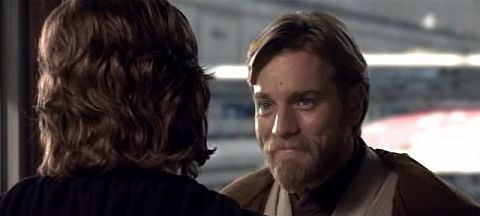
Despite the fact that Obi-Wan is one of the series' best characters, we don't learn much about him in this movie that we did not already know. On the surface he is the model Jedi; a man who obeys the Code and selflessly gives of himself for the sake of the Order, and for the Republic. But underneath the surface he was more than a model Jedi; he actually cared for his student. While he never said anything to either Anakin or Padmé, it's obvious by the time he comes to Padmé near the end of the film that he has known about their tryst for some time, and that he kept his mouth shut out of loyalty to his protégé and friend. In short, unlike Yoda, Obi-Wan allows emotions to affect his judgment. He loves Anakin like a brother, and they both know it. So does Palpatine, which is why he waited until Obi-Wan was away before revealing his true nature to Anakin. Both Dooku and Palpatine knew from early on that Obi-Wan was Anakin's anchor, and that Obi-Wan would have to be removed (one way or another) in order to turn Anakin to the Dark Side.
We also learn that (to put it bluntly) Obi-Wan is a lot smarter than Anakin. Anakin may have the power, but Obi-Wan clearly has the brains. During their duel on Mustafar, Obi-Wan knows he's outmatched so he continually gives ground. As many people knowledgeable in the art of sword-fighting have explained, a weaker sword-fighter can last quite a long time against a superior sword-fighter if he keeps giving ground as Obi-Wan did. And Obi-Wan knew that Anakin was all about balls and glory, so he led him out into the fiery hell outside the shielded confines of the building. It seems obvious that his plan was to lure Anakin into a situation so incredibly dangerous that there was a good chance that they would both die, thus Obi-Wan would take Anakin with him. The fact that he ended up with an outright victory due to Anakin's overconfidence was a bonus.
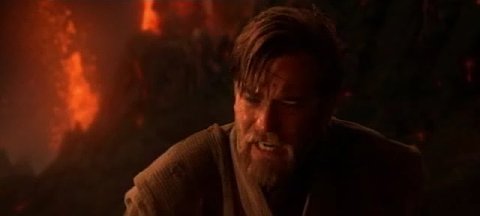
And finally, we learn something about Obi-Wan's "certain point of view" nonsense in Episode 6. For years people have derided his "certain point of view" comment as nothing more than an excuse for lying to Luke about Vader killing Luke's father. But in his film, we can see that this story about Vader killing Anakin is something that Obi-Wan needs to believe for his own sake. All throughout his fight with Anakin on Mustafar, Obi-Wan keeps trying to convince Anakin to come back to his side. Even at the end, when he has the high ground, he warns Anakin not to try it, for his own good. But when he does try it, and when Obi-Wan is forced to defend himself, he finally has to confront the reality that Anakin has irrevocably become Darth Vader, and that his friend Anakin won't be coming back. At that moment, all his years of stiff upper-lipped Jedi reserve finally break down. He has what appears to verge on an emotional breakdown, tearfully wailing in despair at Anakin for what he has become. And we can sympathize that in the years to come, in his solitude on Tatooine, he buries this pain and tells himself that Darth Vader betrayed and murdered his friend. As it turns out, Obi-Wan's "certain point of view" was his own.
There seems almost no point describing revelations about Anakin's character developments, since the entire film is already dedicated to this subject and most revelations are painfully obvious. He believed Padmé's unborn children died with her, hence he never bothered looking for them after her death. He says he loves Padmé, but it's a superficial love at best, if it can be said to be love at all. He does not respect her opinions, he will not listen to her entreaties, he does not make her privy to major decisions in his life, and he does not confide in her. Their relationship seems to be based entirely on desire and passion, and he probably fears losing his possession, so he does not reveal any of his vulnerabilities to her. He also cannot confide in Obi-Wan because he is violating the Jedi Code. So his only confidante is Chancellor Palpatine, who ends up knowing him better than either Padmé or Obi-Wan ever will.
And we finally discover why he falls to the Dark Side. Of course, all of the standard archetypal tragic elements are there: the flawed hero who tries to avoid destiny and ends up fulfilling it instead, pride going before the fall, the Disciple betraying the Master, the road to Hell being paved with good intentions, the attainment of Forbidden Knowledge, etc. But this is more tragic than, say, King Lear, because there are so many ways in which Anakin's tragedy could have been averted. King Lear, if you can remember your high school teacher forcing you to read it, is about a man who basically acts like an idiot throughout most of the story. Anakin, on the other hand, tries his best to do the right thing through much of the film but he suffers from self-absorption and an inability to control his emotions, and as we all know, he eventually ends up making some very bad choices in tense situations which, if he could have taken the time to reflect upon them, he might have made differently.
But all of this is obvious, so there is little point elaborating. What about Vader's injuries?
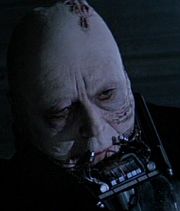 Injury
#1: Facial scars
Injury
#1: Facial scars
When Vader's helmet and facemask were removed many years later in Episode 6, his skin appeared to have largely healed except for a pair of large scars: one on his left cheek and one on top of his head, also on the left side. When you watch Episode 3, you can see that he has neither of these scars when he falls after being cut down by Obi-Wan Kenobi. He falls to the sand and his face is still completely intact. But later, when the Emperor arrives in his shuttle, you can see that he already has the large gash on top of his head, as well as the one on his left cheek. So how did he get them? The flames that severely burned him would not have made these deep gashes by themselves, and no one else attacked him.
It seems reasonable to surmise that, given the violence with which lava is routinely hurled far into the air on Mustafar, flying bits of lava struck him as he lay there on the slope, trying to claw his way up. This might explain the sudden appearance of these facial injuries.
Injury #2: Missing right arm
After Count Dooku cut off his arm in Episode 2, it was replaced by a gold cybernetic arm. The arm he has now in Episode 3 appears to be different than the one he had at the end of Episode 2: silver instead of gold, and more solid-looking. Neither arm has the artificial skin that Luke had for his replacement hand. This has led some to speculate that prosthetic technology has advanced dramatically between Episode 3 and Episode 5, but that seems highly unlikely. There is no apparent advancement at all during that period in other forms of technology, so why would there be such advancement in prosthetics? A much more likely explanation is that Anakin's arm was built for function rather than form. An arm with exposed working parts would be much easier to maintain (especially for someone with Anakin's mechanical skills), and without the need to carefully scale everything to fit inside realistic-looking skin, it could afford to have larger actuators and members, thus making it stronger and tougher.
Injury #3: Missing legs and left arm
When Vader makes the leap from the repulsor platform up to Obi-Wan's position on the rock, he is at one point inverted, and that is when Obi-Wan strikes. He brings up his sabre and cuts through Vader's left arm, and then in the time it takes for Vader to flip over so that his legs are coming down, Obi-Wan finishes his upward follow-through and then smoothly brings it around into a lateral swing, cutting off Vader's legs. You can see the severed limbs falling away if you watch the sequence in slow motion, although their final fate is not known. They do not appear in the next frame where Vader's limbless torso is sliding down toward the lava, and it is difficult to see where they ended up, at least until higher-resolution images become available. Certainly Palpatine appears to have made no effort to recover them.
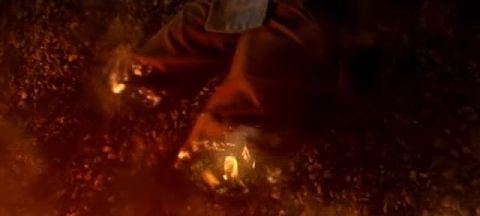
Injury #4: Burn damage
Vader's entire body was severely burned, both inside and out. The novelization describes his injuries further:
You don't even have lungs anymore.
Mechanisms hardwired into your chest breathe for you. They will pump oxygen into your bloodstream forever.
Lord Vader? Lord Vader, can you hear me?
And you can't, not in the way you once did. Sensors in the shell that prisons your head trickle meaning directly into your brain.
You open your scorched-pale eyes; optical sensors integrate light and shadow into a hideous simulacrum of the world around you.
It would appear that he sustained massive injuries to his lungs (presumably suffered by inhaling the scorching hot air), as well as his ears and eyes. It is difficult to see how he survived at all, given such massive damage to his body, but presumably he used the Force to sustain himself until help arrived. Some of these injuries may have healed in the years following Episode 3, as he is able to hear Luke with his own ears after being unmasked in Episode 6. The novelization also exaggerates somewhat by saying that he no longer has any lungs at all, when we know that he has lungs but they are just horribly burned, thus requiring the infamous artificial breathing apparatus which gives him his characteristic breathing sound.
The exact cause of his ignition is not entirely clear. There was no burst of lava striking him, but you could see heat distortion in the air, and it seems likely that the extremely high ambient temperature one would expect from such an environment caused the ignition. Of course, it bears noting that both he and Obi-Wan had been just as close to the lava on many prior occasions, and Obi-Wan had even been hit by pieces of flying lava (as you can see from the burn marks on his clothing later), yet neither of them appeared to be in any danger of ignition.
The lava on Mustafar was extremely "bursty"; so much so that great gouts of flame and lava routinely shot far into the air, which indicates a very volatile mixture of lava and gases. Indeed, when the shielding was shut down over part of the station, the facility took serious damage in mere minutes. Under these conditions, a normal human would probably be killed by the heat or the toxic gases before long, yet Obi-Wan and Anakin fought hard for an extended period in very close proximity to the lava, with no thermal protection or breathing apparatus whatsoever. One can only surmise that they both used the Force to protect themselves during their battle.
Interestingly enough, Anakin did not ignite until some time had passed. He did not ignite when he screamed "I hate you!" at Obi-Wan. He did not ignite until Obi-Wan looked at him with tears in his eyes and said "You were my brother, Anakin. I loved you." Could it be that this outpouring of emotion from his old mentor briefly weakened Anakin's hold on the Dark Side of the Force, thus breaking his concentration and causing him to be lit aflame? That is an unanswerable question, but it is an interesting speculation nonetheless. Once his legs ignited and the pain overwhelmed him, his entire body promptly burst into flame, which would make sense if he was using his powers to protect himself until then.
Injury #5: Damaged vertebrae
When Palpatine blasts Vader with Force lightning in the end of Episode 6, his skeleton is briefly lit up and you can easily see that the top of his spinal cord is obviously artificial:
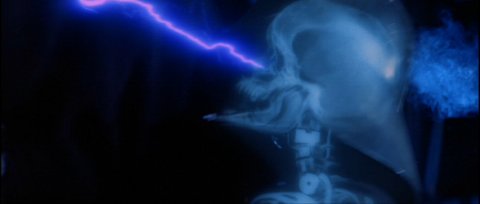 d
d
It remains an unsolved mystery precisely how and when those vertebrae were replaced with artificial devices. It was once speculated that he must have received a neck injury during his battle with Obi-Wan, but now we have seen that battle and no such neck injury takes place. A severing of the spinal cord at that location would make him a quadriplegic if it didn't kill him outright, and he was obviously not paralyzed as he lay on the sands of Mustafar, nor was he paralyzed later as he lay on the operating table on Coruscant. We know this because he was able to move his arms and legs (or what was left of them) and lift his head. Therefore, his spinal cord could not have been severed at Mustafar.
Some have speculated that his neck was broken or his spinal column severed sometime between the events of Episode 3 and Episode 6, thus necessitating the cybernetic replacements we see above. Others have speculated that while his spinal cord was not severed it was severely damaged (perhaps by a piece of lava hurled up into the air which landed on the back of his neck), and it was kept barely functional only by Vader's dark powers. Hence, the droids would replace the severely damaged vertebrae with cybernetic units. If it is very easy for them to do this kind of replacement (and this certainly seems likely, given what we know of the extremely advanced cybernetic technology they possess), this may have been decided upon by the medical team as a more practical solution than trying to slowly nurse severely damaged vertebrae back to their original condition. There may have also been an element of haste involved, since Vader may have been keeping himself alive with the Force, and even with Palpatine helping, this would probably not have been indefinitely sustainable.
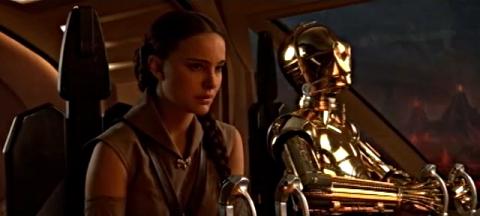
We learn here that C3-PO's mind was wiped by Bail Organa shortly after the events of Episode 3, presumably to keep him from talking about Princess Leia's true lineage. It is unclear why he did not also order R2-D2's mind wiped, since R2-D2 had very extensive knowledge of the situation. It is possible that Organa simply trusted R2-D2 more than C3-PO, but he did not have much experience with either of them, so this seems doubtful. Perhaps the chattiness of C3-PO is simply a known trait of protocol droids, and this was standard practice for any protocol droid who knew too much. In any case, it is interesting that R2-D2 would be openly amused at C3-PO's predicament.
Some have argued that C3-PO's mind could not have been wiped since his personality remained the same. However, his personality appears to have been like that since the day he was activated, so this in itself proves little. He certainly lost something in the way of skills, since he was able to fly Padmé's skiff by himself in Episode 3 but in Episode 4 he said he hated space travel, and never even hinted at the ability to operate a spacecraft in any of the original 3 films. But regardless of how extensive the mind-wipe was, it is quite clear that it did in fact occur.
In the novelization, it is revealed that Padmé gave R2-D2 to Anakin and Anakin gave C3-PO to Padmé as an exchange of gifts, so C3-PO's shiny new gold-plated exterior is presumably a result of Padmé's hand-craftsmen improving his appearance. Anakin, for his part, apparently made extensive modifications to R2-D2, who already had numerous nonstandard enhancements from Naboo technicians who already like to upgrade their astromech droids beyond factory specifications. Some of these modifications may have been responsible for R2-D2's unusual abilities and aggression factor, while his physical toughness (demonstrated when he fell into a pile of battledroid parts without significant damage) is probably due to his original design.
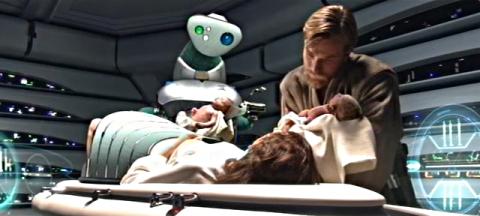
In Episode 6, Princess Leia tells Luke that she has fleeting memories of her "real mother": that she died when Leia was very young and that she was very sad. We learn in Episode 3 that this is impossible: Padmé died mere minutes after Leia was born. This could be interpreted as a glaring inconsistency, but then again, it may be a "programmed memory", whereby someone who has been told a story enough times feels she can "remember" it as if it's a real memory.
I have personally met people who insist that they can remember the day of their own births, even though this is quite impossible. So it is not unlikely that Leia could have pestered her adoptive parents for information about her real mother and they made up some story which she took as real (remember that they wanted to keep her relation to Padmé a secret, so it's not likely that they would tell the truth). Over the years, the distinction between this pseudo-memory and her real memories might have blurred until she sincerely believes it is a real memory.
It stands to reason that Luke would be able to find out all he wants to know about his birth mother if he asked Obi-Wan's ghost, but perhaps Obi-Wan's ghost is not talkative enough to engage in such questions. He might also be able to find out by asking R2-D2, but this might simply not have occurred to him. Since they were born in secret, there would be no official records linking them to Padmé, nor would there be any official records linking Padmé and Anakin Skywalker, so discovering this information through official channels would be a fruitless endeavour. Interestingly enough, despite the wealth and fame of their birth mother, it is possible that neither Luke or Leia ever did figure out who she was. Indeed, there is no indication that Bail Organa's own wife (Leia's adoptive mother) even knew who she was, because Bail could have kept that knowledge from her.
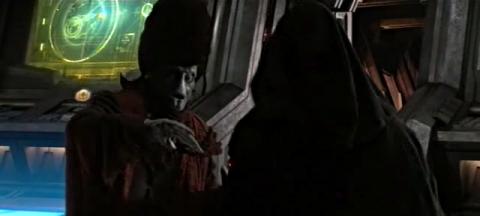
The Confederacy of Independent Systems, or CIS, appears to be composed of many tens of thousands or perhaps hundreds of thousands of systems (remember that in Episode 2, Dooku casually mentioned "another ten thousand star systems" joining their cause). Given Tarkin's quote in the original Episode 4 novelization about a "million system" Empire, one would expect the CIS systems to number at least a few hundred thousand total in order to represent such a threat to the Republic at large, unless the CIS systems happen to possess a disproportionate share of the galaxy's wealth and industrial capacity.
Of course, that possibility should not be ruled out. We know that the principal members of the CIS were large industrial and financial conglomerates: the Trade Federation, the Commerce Guild, the InterGalactic Banking Clan, the Techno Union, the Hyper-Communications Cartel, and the Corporate Alliance, not to mention Geonosian Industries. In fact, all of the members of the CIS are either financial or industrial powerhouses. Of course, they are not the only industrial and financial powerhouses in the galaxy; Kuat Drive Yards, Incom Systems, Corellian Engineering Corp, Sienar Fleet Systems, and the Kaminoan cloners built the backbone of the Republic: its vast fleets and armies. In a sense, the Clone Wars were as much between different corporations as they were between different governments. The corporations which remained loyal to the Republic came out of the war immensely enriched, while the corporations which attempted to break away from Republic rule were crushed: their wealth and power broken for all time.
But what did the CIS hope to gain by breaking away? That is never made entirely clear, but Episode 1 hints at the reason, by mentioning "the taxation of trade routes" as the principal motive for the Trade Federation's actions. Is taxation a sufficient reason to engage in open rebellion, risking death and destruction? Perhaps, and perhaps not. But it is noteworthy that one of the rallying cries of the American Revolution was "no taxation without representation", and the American rebels certainly risked a great deal in order to break away from their faraway masters. The CIS is primarily composed of Outer Rim systems, and we know from Episode 1 that Outer Rim systems (such as Tatooine) are accustomed to a high degree of autonomy, breaking Republic laws with impunity and refusing to deal in Republic financial currencies.
Therefore, it may be that the Outer Rim systems had grown accustomed to this high degree of autonomy over many centuries, and that Chancellor Valorum, alarmed by the increasing anarchy and corporate control over the Outer Rim territories, attempted to re-assert Republic control by taxing these corporations in order to limit their growth (in Episode 1). This in turn led the corporations, starting with the Trade Federation, to openly defy the Republic and threaten to break away: a process which probably hastened after Chancellor Palpatine's succession (it seems reasonable to surmise that he tightened controls on Outer Rim corporations). Hence, the Clone Wars. The rhetoric on both sides, if this hypothesis holds true, is therefore predictable. Count Dooku would feed rhetoric about "freedom" and "independence" to the separatists, along with voluminous explanations of how corrupt the Republic government is. Chancellor Palpatine, on the other hand, would feed his people rhetoric about ruthless, lawless corporations intent on destroying the rule of law and the will of the people (the majority of whom still seem to live in the Core systems).
One open question is: how and why did the leaders of the Separatists become so obedient to Darth Sidious? It is obvious why he would find them useful, as pawns in his great game. But what is their angle? What did they expect to gain by obeying him? No doubt he could have promised them everything under the Sun: reduced regulations, untold wealth, etc. But unless they believe these promises to be credible, they're not going to get in line and obey him. Somehow, he must have convinced them that he was capable of delivering on his promises. Perhaps he painted himself as someone who had very high connections in the Senate or someone in the Chancellor's inner circle, and proved his credentials to them by "influencing" himself as Chancellor Palpatine to take actions or say certain phrases in speeches. As the war continued, he might have maintained his credibility to them by feeding them tactical and strategic information: just enough for them to score crucial victories and allow them to maintain pressure on the Republic.
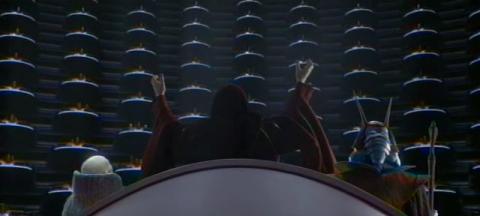
As we see in the infamous "sound of thunderous applause" scene, the Galactic Senate is generally servile to Palpatine's wishes. But it is unclear precisely how this was accomplished. Did Palpatine create a political atmosphere of extremist nationalism, reminiscent of McCarthyism, where dissent or open criticism of the administration was considered treasonous? That would add an extra layer of meaning to Anakin's slightly threatening tone when he admonished Padmé that "you're starting to sound like a separatist". The novelization (as well as Obi-Wan Kenobi in Episode 2) makes reference to Palpatine's exceptional political skill, particularly his ability to manipulate peoples' passions and prejudices. This would also be consistent with the idea that he had successfully created a McCarthy-like atmosphere in the Republic. The nature of a representative body like the Senate is that its members will tend to do or say whatever they feel is necessary in order to hold onto their privileged positions. If Palpatine had created a general cultural atmosphere similar to McCarthyism, then most of the Senators would quickly fall into line, and indeed, it is likely that they would do so most enthusiastically, in an effort to demonstrate to their constituents that they share their feelings.
But this alone is insufficient to explain the Senate's servility. Neither Padmé Amidala or Bail Organa spoke out during this Senate Assembly, and given their passionate opposition to the Empire, that seems most unlikely unless they feared reprisals of a much more immediate and threatening nature than political dissatisfaction at home. Therefore, it seems likely that by the time of Episode 3, Palpatine has so much of the apparatus of Empire in place that the Senate is already nothing more than a rubber-stamp organization, with no real power. In that sense, the change from Republic to Empire is almost a mere act of symbolism, since he seems to have much of the power of an Emperor already.
More evidence for this comes from the seemingly complete lack of governmental conflict with the media. Even when the Supreme Chancellor of the Republic has been kidnapped by General Grievous and then rescued in a dramatic operation, there are no reporters to greet him when he lands. Indeed, there is no indication of an independent media at all. He meets representatives of the Jedi Council in apparent privacy despite being in a wide-open area. This rather strongly suggests one of three possibilities:
There is no press, and the citizens of the Star Wars galaxy are simply not that curious about politics and current events. This seems unlikely, to say the least. Especially in light of the novelization, which describes the citizens of the Republic breathlessly following the latest news about the war.
There is an independent press, but its activities are heavily restricted by the government due to the current state of emergency.
There is no independent press, and news services are provided by the state.
Obviously, #2 and #3 are more likely than #1, but it is difficult to determine whether #2 or #3 is more likely. By the time of Episode 4, it's obvious that whatever news services exist are state-controlled, but at this point in time it is less clear.
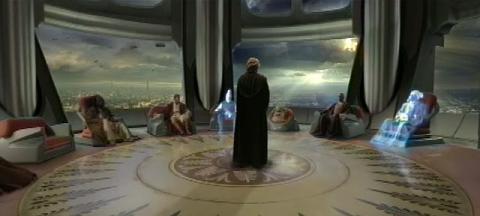
The question of the Jedi Order's place in the governmental hierarchy has always been somewhat unclear, but in Episode 3 we learn that the Jedi serve as generals for the Republic Army, and that most of them seem to lead from the front. This is a dangerous practice to be sure, but presumably less so for a Jedi (although it is noteworthy that Yoda, who once complained about Jedi overconfidence, chose not to lead from the front, and was the only Jedi to survive Order 66 other than Obi-Wan, who survived only by sheer luck). On Coruscant their exact place in the system is not as clear: they do not seem to take direct orders from Palpatine, as Anakin pointed out by saying that they "elect their own members" regardless of what Palpatine wants. They also rebuked any implication of Palpatine's influence over their actions by doing the exact opposite of what he seemed to want and sending Obi-Wan Kenobi to face Grievous without Anakin at his side. They even seem to feel that they have enough authority to depose Palpatine and then "take control of the Senate"; in essence performing a palace coup.
What did they feel gave them this authority? It is highly doubtful that they had any such legal authority. In the absence of the Chancellor one would normally expect a lesser official to take charge (all well-organized governments have a line of succession defined in case the head of state dies), and the Jedi were obviously not in this line of succession, or they would considered their position as part of their planning. Instead, they said nothing about any line of succession (which suggests that they intended to depose not just Palpatine but the entire chain of governmental command) and in their plans they jumped straight to seizing control of the entire Senate at the same time that they arrest, eliminate, or neutralize Palpatine.
So the Jedi were clearly intending to violate all of the applicable laws of the Republic in their coup, but what did they feel would grant them the power to do this? Not the law, so perhaps they expected to use force. However, while Jedi are formidable warriors, particularly one on one, they cannot hope to defeat an army on their own. Therefore, it is possible that each Jedi general expected his army to stay loyal to him rather than the government, in a fashion similar to that of ancient Roman armies which often had more allegiance to their general than they did to Rome itself. This expectation is perhaps even probable, given the near-fanatical loyalty and obedience to orders that was the mark of the clonetrooper corps. But of course, the Jedi did not know about Order 66.
Regarding Jedi abilities, we already saw this in Episode 2, but nevertheless, this film shows again that while Jedi can survive long falls, violent physical shocks (such as grabbing onto an airspeeder as it hurtles by), prolonged exposure to lethal nerve gas (as seen in Episode 1), and searing heat, they can't survive blaster bolts. However, they can take a lot of hits before dying. Weapons which reliably destroy battledroids with a single hit seem to only slightly injure a Jedi, requiring large numbers of hits in order to ensure a kill. Also, we learn that Yoda can sense the death of Jedi from thousands of light years away, and that this is seemingly instantaneous (or at least, so quick that he realizes what's happening before many of the galaxy's clonetroopers even receive the order).
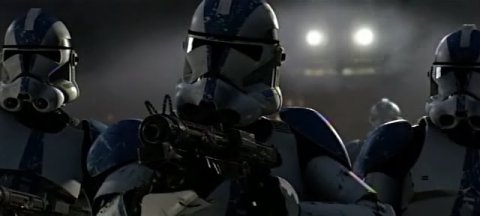
What do we learn about the Grand Army of the Republic in this movie? Well of course, we see some new vehicles and weapons, but on this page we are more concerned with the people, and more specifically the clonetroopers. In Episode 2, Lama Su says that clonetroopers have been genetically modified to be more obedient to authority, and we see that they live in a completely cloistered environment of indoctrination since birth. In this movie, we see just how far that indoctrination goes: after fighting alongside the Jedi Knights for years, and even being willing to sacrifice their lives to protect these comrades in arms, the clonetroopers turned on them, without a trace of hesitation or regret, the instant Palpatine gave the order.
Some have speculated that the Jedi cannot sense attacks if there are no emotions of malice, apprehension, or hatred on the part of their attackers. The novelization even supports this idea, but in Episode 2, both Obi-Wan and Anakin sensed the impending attack of a pair of poisonous giant worms: animals which are basically mindless and which obviously don't consciously feel malice or hate. But we also know that the Jedi can sense emotions in others, so this speculation is not entirely without merit: it is just slightly exaggerated. The Jedi can still sense danger without malice, fear, or hatred on the part of their attackers, but every little bit helps, and those extra cues might give a Jedi the edge he needs. After all, combat is hardly a safe bet under any circumstances, and even the smallest edge can potentially make the difference between life and death.
But how was Order 66 recorded? There could not have been an official record of Order 66, otherwise the Jedi would have discovered it. So it must have been recorded unofficially, yet every single clonetrooper seemed to know what it was. This precludes careful training of a select few in secrecy. The most popular explanation is that the clonetroopers were indoctrinated with this order as part of their training program, and the Jedi never bothered to carefully inspect that training program. But that raises the question of what the Kaminoans would think when they were instructed to embed a special "Order 66" in every clonetrooper's training program, which involved the extermination of Jedi Knights (particularly when the order for the Clone Army was apparently placed by a Jedi Master: Sifo Dyas). One could imagine that some rationale was given for this unusual instruction, or that the Kaminoans are simply not the type to ask questions. Note that this also implies that Darth Tyrannus (Count Dooku) worked closely with the cloners when developing their training programs (quite likely, since he was the one who apparently selected and recruited Jango Fett as the template for the clone army).
In the novelization, Yoda states that there is no point hiding the bodies of clonetroopers they ambushed and killed while sneaking into the Jedi Temple because no clonetrooper would be missing from his post unless he were dead, so a missing clonetrooper would raise just as much of an alarm as a dead clonetrooper. One can only conclude from this and other incidents that clonetroopers are exceptionally disciplined troops. The Imperial stormtroopers and scout troopers of the original trilogy are also quite disciplined in many situations, but not as consistently so as the original Republic clonetroopers; this lends credence to the idea that once the Empire was in place, Palpatine started recruiting men into his army the old-fashioned way rather than relying exclusively upon clones.
Clonetrooper tactics seem to vary from good to abysmal, and the Separatist attack on the Wookies was a good example of that. Clonetroopers had dug trenches, set up a killzone, and taken up firing from elevated positions, and they were in the process of bringing their heavy armour to the beach when the Separatists attacked. So far, so good. However, at that moment numerous clonetroopers leapt up from their prepared positions and charged toward the Separatists, taking totally unnecessary casualties in the process. Is this due to poor tactical training, or some kind of irrational Spartan warrior code? That is unclear, although the fact that they can use prudent tactics suggests that they are aware of ways they can use to reduce their casualties, but they don't consistently use them.
The logistical difficulties of breeding enough clones to combat the vast numbers of war droids being manufactured by the Separatists would dictate that the Clone Army must fight with a numerical disadvantage much of the time. This may be offset to some degree by what appears to be naval superiority, but one cannot use orbital bombardment to dislodge the enemy from an occupied city unless you are willing to sacrifice that city and all of its inhabitants: an unpalatable choice in what is still a Republic. Given the long ten-year delay between conception and training completion, clone armies simply cannot be raised as quickly as droid armies or even conventionally recruited armies. Therefore, it seems most likely that clonetroopers were used as an elite force rather than constituting the entirety of the Republic's military forces as some have suggested.
Of course, even as an elite force which is used to reinforce local system militias (as was implied to be the case at Kashyyk), they would still need substantial numbers in order to make a difference on a galactic scale. Some absurdly low numbers have been bandied about in some sources (as low as 3 million men total, according to an article published in Star Wars Insider #84), but to put those figures into the perspective of a million-system civilization, it would be like having a US Army Ranger force on Earth which consists of just three men. Even with superior tactics and training as well as a Special Forces role, there are limits to how much a massively undermanned outfit can possibly accomplish, especially in the face of "quadrillions" of battle droids according to the same source! And why, if the Grand Army was actually a tiny SpecOps unit, was it called the Grand Army? Does the term "Grand Army" not necessarily imply that it is, well, grand?
Realistically, if the battledroids number in the quadrillions, then the Grand Army must be similarly large, at least to within the same order of magnitude. Regardless of whether it is composed of clones, a mix of clones and regulars, or 99.9% regulars and 0.1% clones, the "3 million" figure is grotesquely unrealistic.
The nature of hyperdrive means that any system anywhere in the galaxy is always within striking range (even Coruscant, as demonstrated dramatically in the beginning of Episode 3). Given that reality, many of the normal strategies of war do not apply here. When Alexander the Great conquered his vast territories, he did so with an army that needed days, weeks, or months to move from one place to another. In Star Wars, any fleet or army can be moved from any point in the galaxy to any other point in the galaxy in mere hours. This overturns many strategic principles and requires a certain amount of rethinking, in terms of conventional military strategy. In a war fought with this kind of technology, there are no front lines. There is no area which is so far from the action that its occupants can consider themselves safe. The only safety in such an environment would be purchased not with distance, but with the implements of war: hastily constructed shield networks, planetary garrisons, and heavily armed star fleets.
The public would experience a more immediate kind of fear in this sort of war than they would in a more conventional present-day war, particularly in light of the Separatist inclination to engage in atrocities (see General Grievous). In order to keep public morale high, the Republic would have to make promises which are difficult to honour: it would have to expend great sums of money ensuring that all of the most important systems are heavily defended, and it would have to spread its forces around the galaxy in order to make sure they can respond almost immediately to an attack on a member system. Without these efforts, public morale could drop, and in the still-democratic Republic, this could mean that the public might force the government to come to terms with the enemy.
A typical Separatist assault on a wealthy member world would probably consist of a fleet dropping out of hyperspace to attack a planet. Assuming the planet had enough lead time to activate planetary shielding, the battle would then consist of its defense forces engaging the attackers while the attackers try to wear down the shield. All this would have to take place while the nearest Republic star fleet is alerted and rushes to aid the besieged system. A typical Separatist assault on a less prosperous member world (such as the Wookie homeworld of Kashyyk) would probably consist of the Separatist fleet simply landing its forces without much opposition (assuming the Separatist leadership was not so incensed at this system that they would simply incinerate its occupants from orbit).
In both cases, Republic forces would have to respond quickly, or risk losing the system. But lest you think that the Separatists can easily manipulate Republic military forces by forcing them to spread themselves thin, remember that the Republic can do the same thing to the Separatists by going on the offensive. Indeed, this is alluded to when Obi-Wan speaks of the "Outer Rim Sieges". And the Separatists are a political entity just like the Republic; they cannot afford to have their member worlds lose confidence in their leadership. So where does the strategic balance fall, and how can it be that the Republic is "crumbling" even though we hear later from Obi-Wan that the Outer Rim sieges are going very well?
The Republic's ability to force Separatist systems to surrender via siege necessarily implies the ability to achieve and then maintain space superiority over a system for an extended period of time, despite the speed with which large Separatist fleets can be moved across long distances. This, in turn, implies that the Republic enjoys a general tactical advantage in space battles. It is unclear whether this advantage is due to tactically superior warships, a larger fleet, or perhaps crew skill (note that they use human crewmen rather than droids). It is also unclear whether the Republic star fleets are crewed by clones or recruits. The fact that many crewmen are seen wearing the iconic clonetrooper armour does not necessarily mean that they are clones; they might be recruits who are simply wearing the same armour as clonetroopers. After all, the Republic star fleets existed before the Clone Army did.
If it is in fact true that the Republic enjoys superiority in space (a speculation which is further substantiated by the rapid encirclement and defeat of Grievous' forces in orbit around Coruscant), then logically, the Separatists would seek to take worlds and distract Republic forces by attacking systems on the ground. This would require that they choose systems which lack the necessary defenses to prevent hostile landings, and which will therefore facilitate an immediate landing of troops. This is what we saw them do at Kashyyk. The Republic would then be forced to deploy ships and men to that system, regardless of its military-industrial significance, in order to maintain its pretense of being able to provide security for its citizens. In short, Kashyyk was a system they could not afford to lose not because of its industrial output (which appears to be meager) but because the loss of any heavily populated planet, particularly a species homeworld, would represent a public failure for the Republic and a crippling blow to public morale.
If the above speculation is correct, then the Separatists probably dealt themselves a very serious blow with the failed attack on Coruscant. They probably devoted a significant fraction of their star fleets to this assault, and when it was defeated, the Republic dominance in space would only be greatly enhanced. Moreover, after the destruction caused by the brazen Separatist assault on the Republic throneworld, it seems likely that an enraged public would be quite willing to let the Republic star fleets unleash their full destructive power upon Separatist targets which had heretofore been protected by humanitarian rules of engagement. While the Republic may have been "crumbling" from the Separatists' constant use of probing and harassing attacks, this "crumbling" was probably political rather than physical. With a key (and strategically important) victory and righteous anger over the perceived atrocity of attacking such a prominent civilian target, the Republic would probably have been capable of swiftly crushing the Separatists even if Darth Sidious had not already ensured their surrender beforehand.
Continue to Revelations #2: The Technology
Rebecca, for notes about Mace Windu and R2-D2's many modifications. And also for bearing my children and being the love of my life, of course ;)
Many forum users (too many to practically list; believe me, I tried), whose contributions can be seen at http://bbs.stardestroyer.net/viewtopic.php?t=69634.
Lord Revan, for the "barbecue heat reflection plates" idea regarding General Grievous.